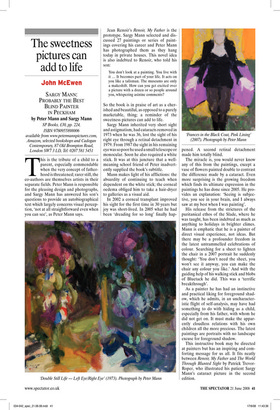The sweetness pictures can add to life
John McEwen
SARGY MANN: PROBABLY THE BEST BLIND PAINTER IN PECKHAM by Peter Mann and Sargy Mann SP Books, £30, pp. 224, ISBN 9780955898006 available from www.petermannpictures.com, Amazon, selected bookshops and Cadogan Contemporary, 87 Old Brompton Road, London SW7 3 LD, Tel: 0207 581 5451 This is the tribute of a child to a parent, especially commendable when the very concept of fatherhood is threatened; rarer still, the co-authors are themselves artists in their separate fields. Peter Mann is responsible for the pleasing design and photographs, and Sargy Mann has answered his son’s questions to provide an autobiographical text which largely concerns visual perception, ‘not at all straightforward even when you can see’, as Peter Mann says. Jean Renoir’s Renoir, My Father is the prototype. Sargy Mann selected and discussed 27 paintings or series of paintings covering his career and Peter Mann has photographed them as they hang today in private houses. This novel idea is also indebted to Renoir, who told his son:
You don’t look at a painting. You live with it ... It becomes part of your life. It acts on you like a talisman. The museums are only a makeshift. How can you get excited over a picture with a dozen or so people around you, whispering asinine comments?
So the book is in praise of art as a cherished and beautiful, as opposed to a purely marketable, thing; a reminder of the sweetness pictures can add to life.
Sargy Mann inherited very short sight and astigmatism, had cataracts removed in 1973 when he was 36, lost the sight of his right eye through a retinal detachment in 1979. From 1987 the sight in his remaining eye was so poor he used a small telescope or monocular. Soon he also required a white stick. It was at this juncture that a wellmeaning school friend of Peter inadvertently supplied the book’s subtitle.
Mann makes light of his afflictions: the absurdity of continuing to teach when dependent on the white stick; the corneal oedema obliged him to take a hair-dryer to galleries as a visual aid.
In 2002 a corneal transplant improved his sight for the first time in 30 years but joy was short-lived. In 2005 what he had been ‘dreading for so long’ finally hap pened. A second retinal detachment made him totally blind.
The miracle is, you would never know any of this from the paintings, except a vase of flowers painted double to contrast the difference made by a cataract. Even more surprising is the growing freedom which finds its ultimate expression in the paintings he has done since 2005. He provides an explanation: ‘Seeing is subjective, you see in your brain, and I always saw at my best when I was painting’.
His release from the strictures of the puritanical ethos of the Slade, where he was taught, has been indebted as much as anything to holidays in brighter climes. Mann is emphatic that he is a painter of direct visual experience, not ideas. But there may be a profounder freedom in the latest untrammelled celebrations of colour. Searching for a sheet to lighten the chair in a 2007 portrait he suddenly thought: ‘You don’t need the sheet, you won’t see it anyway, you can make the chair any colour you like.’ And with the guiding help of his walking stick and blobs of Bluetack he did. This was a ‘terrific breakthrough’.
As a painter he has had an instinctive and practical liking for foreground shadow, which he admits, in an uncharacteristic flight of self-analysis, may have had something to do with hiding as a child, especially from his father, with whom he did not get on. It must make the apparently cloudless relations with his own children all the more precious. The latest paintings are portraits with no landscape excuse for foreground shadow.
This instructive book may be directed at painters but has an inspiring and comforting message for us all. It fits neatly between Renoir, My Father and The World Through Blunted Sight by Patrick TrevorRoper, who illustrated his patient Sargy Mann’s cataract picture in the second edition.










































































 Previous page
Previous page